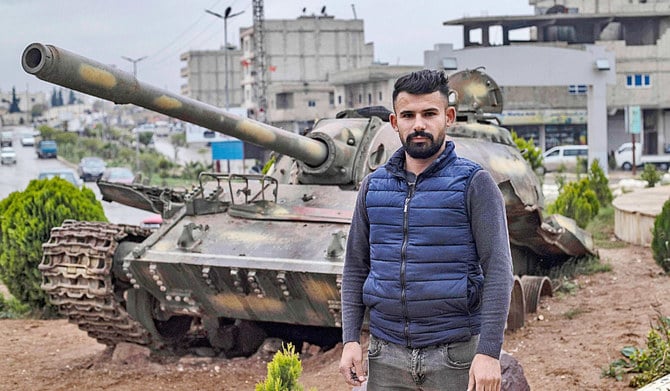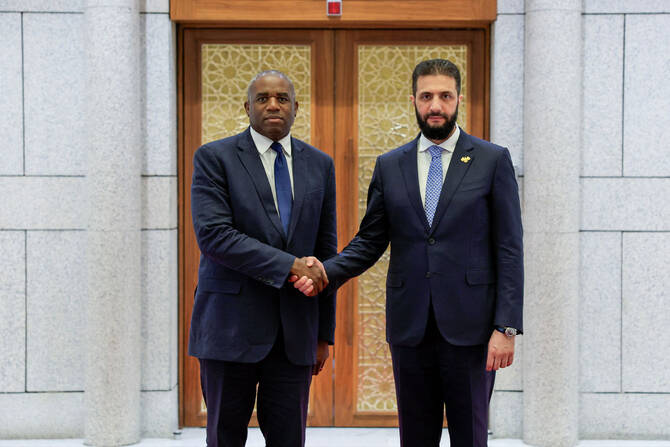“Daesh destroyed these buildings,” the local baker said.
That danger has passed, but now, he says: “Turkiye wants to destroy the rest of the city.”
Since Sunday, Turkiye has carried out airstrikes against the semi-autonomous Kurdish zones in north and northeastern Syria, and across the border in Iraq.
Those raids, which started in Kobane, have killed 58 Kurdish fighters and Syrian soldiers as well as a Kurdish journalist, the Syrian Observatory for Human Rights said.
Ankara has threatened a ground offensive and made clear that Kobane, also known as Ayn Al-Arab, would be a primary objective.
US-supported Syrian Democratic Forces, now the Kurds’ de facto army in the area, led the battle that dislodged Daesh fighters from the last scraps of their Syrian territory in 2019.
Years before, in 2015, Kurdish forces drove Daesh from Kobane, on the border with Turkiye, and the city became a symbol of their victory against Daesh.
To keep the memories of the combat alive, Kurdish authorities erected a cordon around a group of destroyed buildings, burnt-out vehicles and missile remnants, dubbing the area the Kobane “museum.”
While the football World Cup in Qatar has captured some residents’ attention, tension can be read on their faces.
Most fled the combat with Daesh before slowly returning and rebuilding.
“We fought Daesh for the whole world, and today the world closes its eyes and acts like an ostrich while Turkiye bombs,” said the baker Khalil, 42.
One week after a bombing in Istanbul on November 13 that killed six people and wounded 81, Ankara said it launched air strikes from “70 planes and drones” against Kurdish bases in Iraq and Syria, starting with Kobane.
Turkiye blamed the Istanbul bombing on the Kurdistan Workers’ Party — designated a terrorist group by the EU and the US — and said it was ordered from Kobane.
The PKK has waged an insurgency against the Turkish state since 1984, and Turkiye alleges that Syrian Kurdish fighters are the group’s allies.
Kurdish groups denied any involvement in the Ankara blast.
Turkiye then hit other areas including the SDF bastion of Hasakeh province, in the northeast, and President Recep Tayyip Erdogan vowed Tuesday that Turkiye would “soon” begin a ground operation.
“The situation in Kobane is bad. People don’t sleep at night” out of fear that the city could be “bombed at any moment,” said Nabo Jumaa Ramadan, who opened a minimart in Kobane after he returned from Lebanon in 2019.
“Kobane is a symbol for the Kurds and she defeated Daesh,” Ramadan said with pride. Erdogan wants to “break the will of Kurds in the city,” according to Ramadan.
“If Kobane falls, all Rojava will fall,” he predicted, using the name Kurds in Syria give to the area they administer.
The Kurds faced an earlier Turkish incursion in 2019 when Ankara’s forces and its Syrian proxies grabbed a swathe of land along the frontier.
Under a deal between Moscow and Ankara, Kurdish forces which controlled nearly a third of Syria had to pull back to a line 30 km from the border.
The withdrawal included Kobane.
On Thursday, despite fears of a new ground incursion, there was no visible Kurdish military mobilization in the streets of Kobane, AFP correspondents said.
A civilian vehicle traversed the city-center, calling residents through a loudspeaker to join a demonstration against Turkiye’s strikes.
Even when bombs are not falling, Turkiye’s proximity is hard to avoid, and its flags can be seen along the border from several districts of Kobane.
Flags of Syria and Russia — a major ally of Damascus — are also visible, on a nearby hill with a post for government troops.
“We’re afraid of bombs. We are poor, without possessions or land,” said Amina Youssef, 65, in front of her home.
“We only have this house. What does Turkiye want? We don’t know what to do.”
The trauma spans generations.
“We came back years ago and began to rebuild our homes,” Sherwan Hami, 39, said, sheltering from rain inside a shop.
“The city and the markets prospered and people went back to work,” he said.
“But there’s a new war. We’re living under the bombs again.”
AFP






















